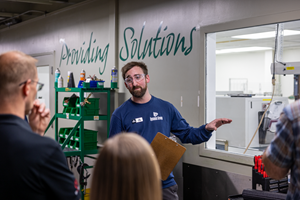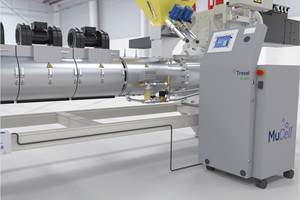Comeback Ignited in Automotive
Wood on Plastics
Our forecast for 2012 calls for the overall rate of growth to be 10%...not quite back to pre-recession levels, but solid progress.
It looks like Clint Eastwood may have been right. Many of you will remember the two-minute Chrysler commercial that ran during halftime of the last Super Bowl. In it, the actor/director/producer confidently proclaimed that the current bout of sluggishness in the economy was just the halftime for America. He then stated unequivocally that very soon the second half would start, and that the U.S. manufacturing sector, the U.S. economy, and the country as a whole would come roaring back, stronger than ever. Because that’s what we do.
Well, it is still quite early in the second half, but the automotive sector has gone ahead and made Clint’s day. For the year to date, sales of new cars and light trucks are up 10% over the corresponding period of 2011. Perhaps reflecting the recent sharp rise in the price of gasoline, unit sales of new cars are up 15% for the year, while the number of light trucks sold (which includes SUVs and minivans) is up only 6%.
Our forecast for 2012 calls for the overall rate of growth to stay at the 10% level, whereby the total number of cars and light trucks sold this year will exceed 14.5 million units. That is not quite back to pre-recession levels, but it is still solid progress.
The aforementioned sales figures include imported vehicles. If we look just at the data for U.S.-built vehicles, the news is even better. So far in 2012, the total number of motor vehicles assembled in this country is up a whopping 22% compared with a year ago. The number of car assemblies has jumped by 44% from 2011, while the number of light trucks assembled has expanded by 10%. The rate of growth in this area will decelerate as the year progresses, but our forecast still calls for a gain in the range of 20% for 2012. This would put the annual total for domestic assemblies well above 10 million units.
This forecast is based on a continuation of the current macro-economic trends in the U.S. These include a gradual rise in overall employment and a corresponding elevation of consumer confidence; persistent strength in corporate profits, which will drive gains in fleet sales and 大象传媒 travel; and most importantly, a steady easing of credit for consumers and small 大象传媒es.
The average age of an automobile in the U.S. is nearly 11 years. This suggests that there is still a great deal of pent-up demand for new cars. So as 大象传媒 and economic conditions continue to improve, this demand will be released. One other factor that is increasingly affecting the market is the price of gasoline. If the price of fuel goes too high (higher than about $4.50/gal) it will act as a strong deterrent for sales of all types of vehicles (and a drag on the economy as a whole). But at the current price levels for gasoline (just shy of $4/gal), the market response is to demand greater numbers of more fuel-efficient vehicles.
As for which car company has performed the best so far, the answer may surprise you. In terms of both the strongest increase in unit sales for the year to date and also first-quarter profits, Chrysler is tops. Ford and General Motors are off to a strong start in the profits category, but their unit growth this year is not nearly as robust as Chrysler’s. Based on these results, I strongly suggest that they retire the trophy for the Best Super Bowl Ad once and for all. For its apparent ability to move the market as well as its pure entertainment value, no commercial will ever top Clint’s two minutes of squinting, scowling, and gravel-throated motivating.
WHAT THIS MEANS TO YOU
•Keep tabs on trends in all-electric cars, natural-gas conversion, and fuel-cell technology. They will all enjoy increasing attention in coming years, and that’s where opportunity will lie.
•Increased attention to these changes will correspond with the continuing trend towards lighter-weight vehicles, which is also good news for plastics processors.
•Due to the negative effects of the tsunami in Japan and the Evonik factory fire in Germany, the supply chain will increasingly be re-shored closer to market in the coming years.
Related Content
First Water Bottles With Ultrathin Glass Coating
Long used for sensitive juices and carbonated soft drinks, KHS Freshsafe PET Plasmax vapor-deposited glass coating is now providing freshness and flavor protection for PET mineral water bottles.
Read MoreMedical Molder, Moldmaker Embraces Continuous Improvement
True to the adjective in its name, Dynamic Group has been characterized by constant change, activity and progress over its nearly five decades as a medical molder and moldmaker.
Read MorePaperless ‘Smart Factory’ Based on Automated Production Monitoring
Tier 1 automotive molder’s home-built production-monitoring and ERP systems, designed for “the little guy,” boost its efficiency rating and profits.
Read MoreFoam-Core Multilayer Blow Molding: How It’s Done
Learn here how to take advantage of new lightweighting and recycle utilization opportunities in consumer packaging, thanks to a collaboration of leaders in microcellular foaming and multilayer head design.
Read MoreRead Next
People 4.0 – How to Get Buy-In from Your Staff for Industry 4.0 Systems
Implementing a production monitoring system as the foundation of a ‘smart factory’ is about integrating people with new technology as much as it is about integrating machines and computers. Here are tips from a company that has gone through the process.
Read MoreSee Recyclers Close the Loop on Trade Show Production Scrap at NPE2024
A collaboration between show organizer PLASTICS, recycler CPR and size reduction experts WEIMA and Conair recovered and recycled all production scrap at NPE2024.
Read MoreBeyond Prototypes: 8 Ways the Plastics Industry Is Using 3D Printing
Plastics processors are finding applications for 3D printing around the plant and across the supply chain. Here are 8 examples to look for at NPE2024.
Read More









